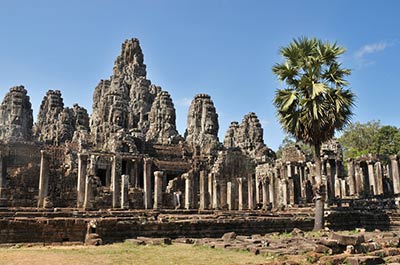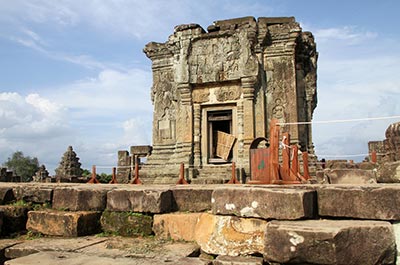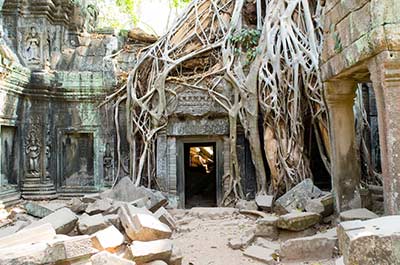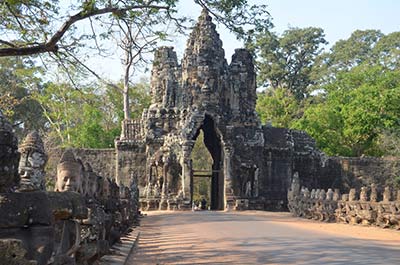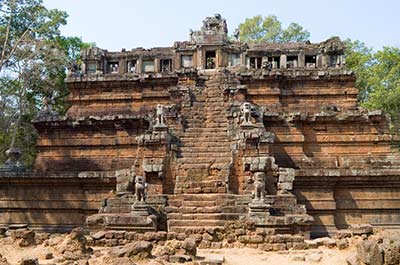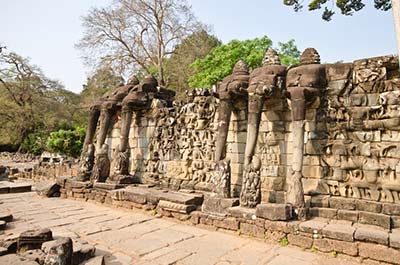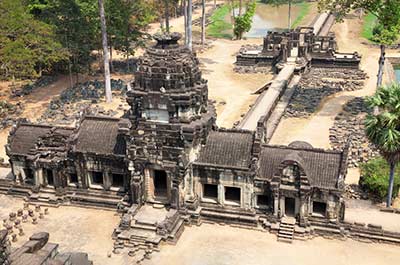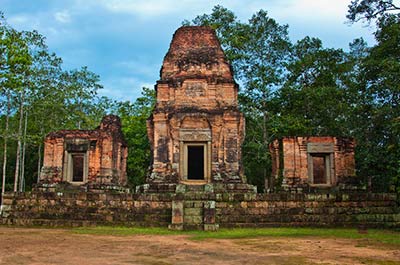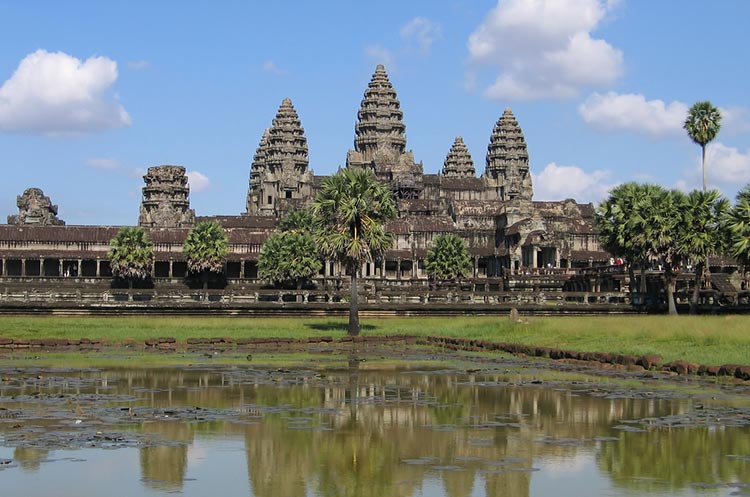
Angkor Wat
Biggest Hindu temple built at the height of Khmer skills
Angkor’s most impressive and best known temple, Angkor Wat is the best preserved of all the Angkor monuments. The temple is an object of pride for Cambodia, its depiction appears on the national flag.
Angkor Wat, which means “temple city” is located just South of the Khmer capital Angkor Thom.
It is a richly decorated, very large temple; the total temple area including the moat measures 1.5 kilometers long by 1.3 kilometers wide, or a total of about two square kilometers. Angkor Wat is the biggest Hindu temple in Cambodia.
Sunrise temple
Angkor Wat is one of the most popular places to watch the sunrise. The easiest way to get there in time is to take an early morning sunrise tour.
Height of architectural skills of the Khmer
The temple represents the height of architectural skills of the Khmer builders. Its very detailed carved bas reliefs that cover much of the temple shows impressive craftsmanship. Unlike other Angkor temples, Angkor Wat is oriented towards the West and dedicated to Vishnu, where previous temples face East and are dedicated to Shiva.
Angkor Wat was the state temple of King Suryavarman II, who built the temple during the first half of the 12th century. He was one of Angkor’s greatest Kings who ruled for almost 40 years and expanded the Khmer empire. Some historians believe that the temple also served as a funerary temple for the King. This could explain its orientation to the West; the setting sun (in the West) symbolizes the end of the cycle of life.
Mount Meru, the center of Hindu cosmology
Angkor Wat is a mountain temple build to represent Mount Meru, the center of the world in Hindu cosmology. The temple’s five prasats or sanctuary towers represent the peaks of the sacred mountain, while the moats represent the oceans that surround Mount Meru.
The temple’s three tiers are surrounded by large galleries, that were introduced in earlier temples like the Ta Keo. One of Angkor Wat’s major attractions are the many intricate and well preserved bas reliefs with depictions of scenes from the epics Ramayana and Mahabharata, as well as many hundreds of statues of female devatas, a Hindu deity.
Angkor Wat was cleared at the start of the 20th century, after which extensive restoration work has been carried out. Around the end of the 13th century Angkor Wat was converted into a Buddhist temple.
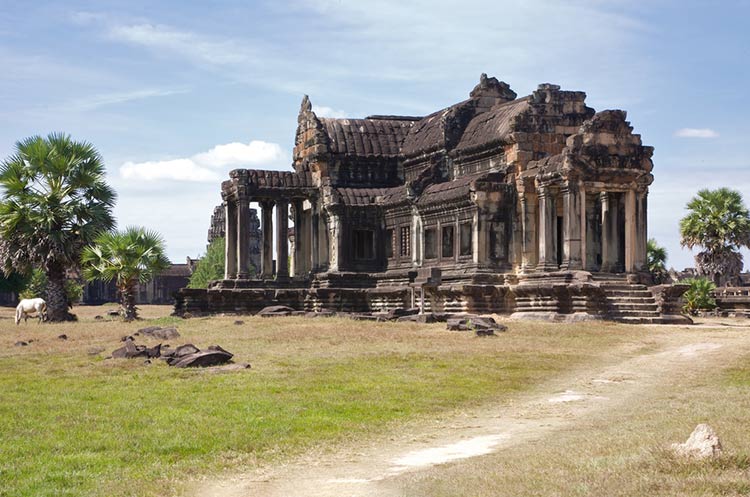
Approach to the temple
Surrounding the temple complex is a 190 meter wide moat. At the Western end is a 12 meter wide bridge, in front of which is a terrace where lions and Naga snakes guard the temple. Crossing the bridge the visitor approaches the impressive Western gate, which was build to resemble the front view of the temple itself.
The structure consists of long galleries with a three part gopura topped by towers that have partly collapsed. At both ends of the structure is a pavilion, large enough to enable elephants to go through. The Western gate contains apsaras and devatas as well as magnificent carvings on its lintels showing Vishnu, Garuda, warriors and scenes from the epic Ramayana. Only after passing the Western gate, the Angkor Wat temple comes in sight.
Processional walkway
Behind the Western gate is a 350 meter long processional walkway elevated about 1½ meters above the ground towards the temple. On either side of the walkway is a library building. Past the libraries are two lakes, reflecting the silhouette of the of Angkor Wat’s towers.
The temple itself is build on raised platform about 330 meters long and 255 meters wide. The structure comprises of three rectangular tiers each higher one smaller than the one below it encircled by long galleries with corner towers and a gopura in the center of its sides.
Bas reliefs galleries of the third tier
The third tier is surrounded by long concentric galleries. Its walls contain some of the finest and best preserved bas reliefs of Angkor Wat, including:
- The battle of Lanka, a story from the epic Ramayana, where Rama fights Ravana who abducted his wife Sita
- The battle of Kurukshetra from the epic Mahabharata, between the Kauravas and the Pandavas, depicting soldiers and commanders on elephants or riding chariots
- A 90 meter panel of the Royal Procession. Two sections depict King Suryavarman II and a procession of court ladies, another section shows a procession of soldiers on foot or on horses and elephants and a parade of Brahmin priests
- The Heavens and Hells and the Judgement of Sinners by Yama, the Hindu God of Death. Depictions of the 37 heavens with palaces with servants and the 32 hells and the punishments and tortures received there, each one for a specific sin committed
- The churning of the ocean of milk, a 50 meter long panel. This story from the Mahabharata tells how an elixir of immortality over which the Gods and the demons fight is produced by churning the ocean with Mount Meru used as the churning rod
- Vishnu and his incarnation Krishna
- The victory of Vishnu over the asuras
- The abduction of Shiva by Ravana
- Other scenes from the Ramayana
Within the third enclosure, right after passing the main entrance on the West end are galleries that delimit four courtyards. Its walls are decorated with devatas, apsaras and rishis, while the pediments contain carvings of Vishnu and Krishna, one of Vishnu’s incarnations. The galleries also contain a number of Buddha images, placed there after Angkor Wat was converted into a Buddhist temple.
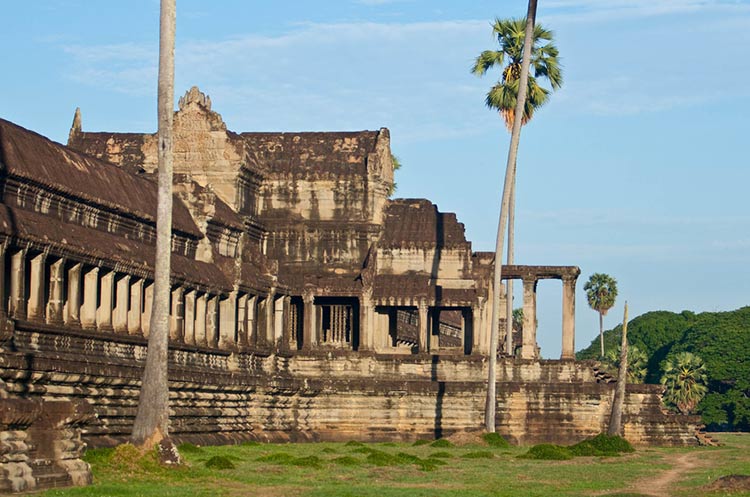
The platform with 5 lotus bud shaped towers
The second tier measuring 100 by 115 meters is enclosed by galleries. On each of its four corners are towers that have partly collapsed. On top of the structure is a square platform about 55 meters wide that contains five towers shaped like lotus buds. The platform is surrounded by galleries, with a sanctuary tower on each if its corners.
In the middle stands the 42 meter high central sanctuary on each side opening to a vestibule in which Buddha statues are found. The walls of the tower are decorated with well preserved devatas. Inside is the cella, a chamber that enshrined a large statue of Vishnu.
Is Angkor Wat a wonder of the world
The classic Seven Wonders of the Ancient World list includes only monuments around the Mediterranean Sea. There are several other wonders of the world lists, among them wonders of nature, engineering and the industrial world. Although not on any of these lists, Angkor Wat is often considered “the 8th Wonder of the World”.
Location
Angkor Wat is located just a few kilometers North of Siem Reap town. The main road to Angkor Wat is the Charles de Gaulle road that runs North from Siem Reap town center. This is the road where the main ticket office is on.
How to get there
A fun way to get there is by tuk tuk.
Find out about prices, how to find a good tuk tuk driver and what to do before the trip.
Alternatively, get there by taxi, motorbike or rented bicycle.
Other Angkor temples:
